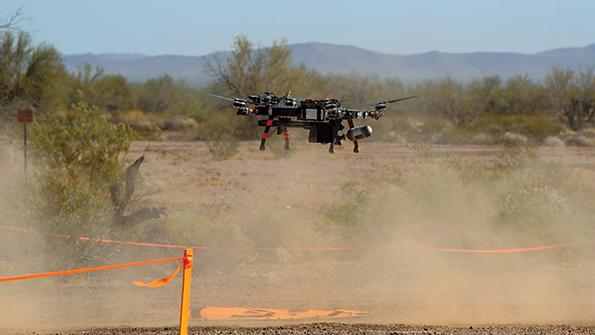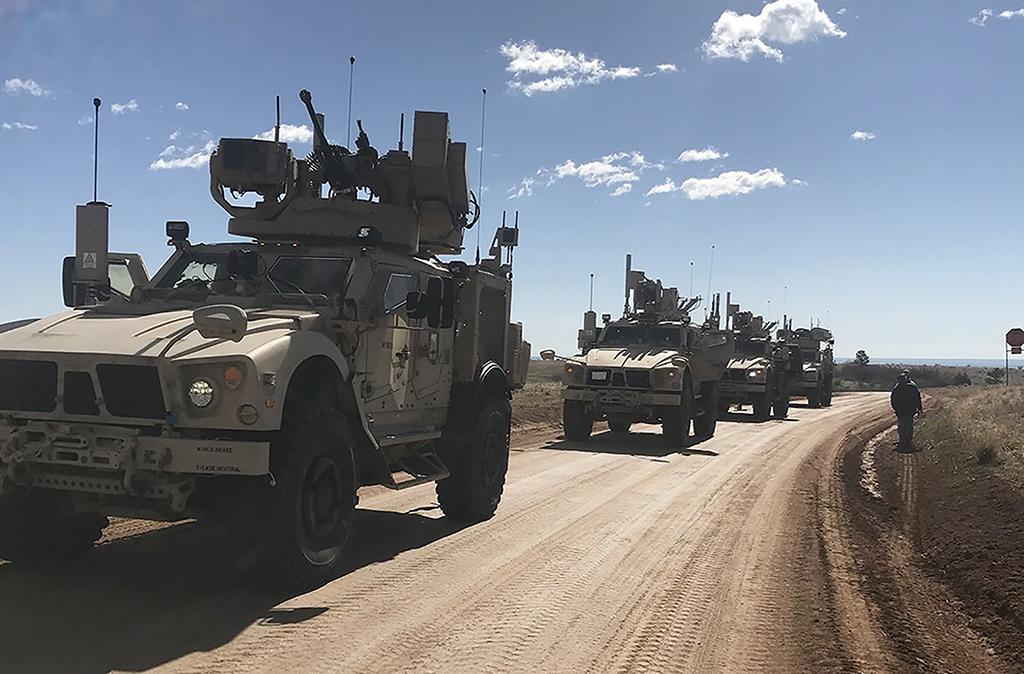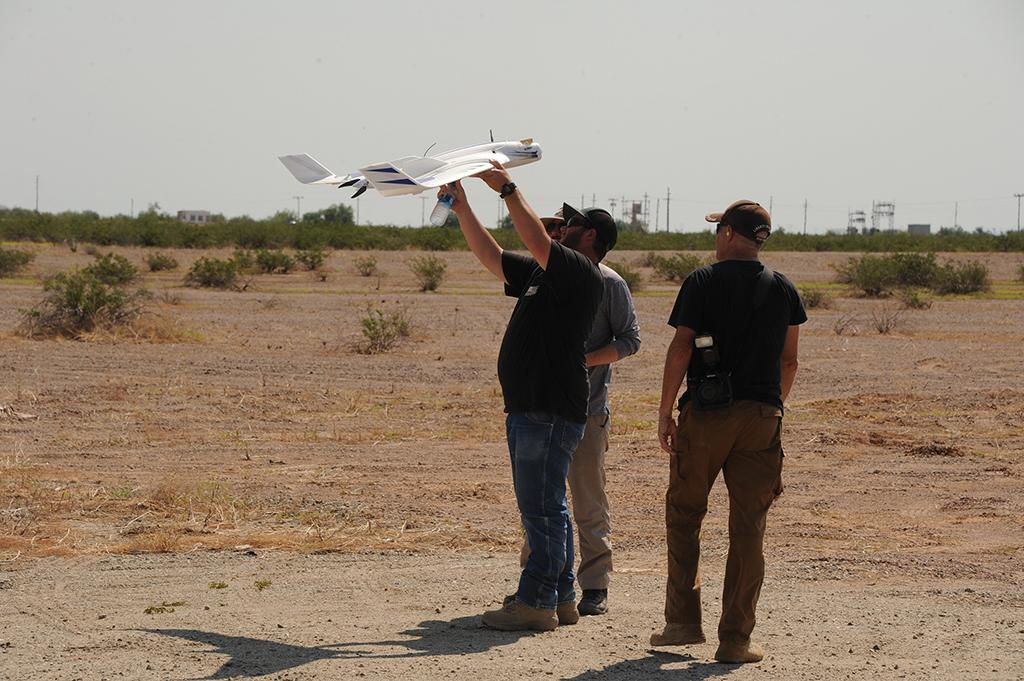
U.S. forces are operating without complete air superiority, with the threat of small, low-cost unmanned aircraft systems proliferating to the point that the Army’s chief says they are the new improvised explosive device.
Countering unmanned aircraft systems (UAS) has become a major priority for all the services, with the Army looking at near-term fixes through demonstrations of existing technologies and a long-term effort to use the service’s major Project Convergence to develop new ways to fight the drones.
- Service is testing cheap, readily available systems
- Project Convergence to look at counter-UAS mission
The Army wants counter-UAS systems that can “pick them up with our sensors, and then you can pick the appropriate weapons system to take that down,” says U.S. Army Chief of Staff Gen. James C. McConville. “[This] may be a missile, gun, directed energy [or] a high-powered microwave. We’ll have multiple arrows in the quiver.”
The use of small UAVs, typically commercially available quadcopters outfitted with small explosives, has spread across the Middle East, with high-profile incidents such as the September 2019 Houthi attack on Saudi Aramco facilities. U.S. bases in Iraq have been targeted by drones, including multiple attempted attacks at Al Asad AB that damaged the facility in May and June.
Like formation of the Joint Improvised-Threat Defeat Organization in 2006 as improvised explosive devices became a major concern, the Army formed the Joint Counter-Small Unmanned Aircraft Systems Office (JCO) in 2019 to oversee the development of protective systems. After publishing its overarching strategy early this year, the JCO’s work has picked up, with multiple demonstrations of potential systems.
“The exponential growth of sUAS [small UAS] creates new risks for the department,” the strategy states. “Technology trends are dramatically transforming legitimate applications of sUAS while simultaneously making them increasingly capable weapons in the hands of state actors, nonstate actors and criminals. Small UAS may also pose hazards to [Pentagon] operations in the air, land and maritime domains when controlled by negligent or reckless operators.”
The most recent demonstration, held Aug. 30-Sept. 17 at Yuma Proving Ground in Arizona alongside the Army’s Rapid Capabilities and Critical Technologies Office (RCCTO), focused on five off-the-shelf systems that target drones using electronic means or projectiles.

“There’s a sense of urgency, and everybody on my team and the community is working hard to close these gaps as quickly as we can,” Col. Greg Soule, JCO director of acquisition and resources, said after the demonstration concluded. “We have soldiers, airmen, Marines and sailors that are in daily [threat situations]—whether it’s just surveillance or kinetic effects from threat UAVs and UAS. So we are definitely working to close these gaps as quickly as we can.” That demonstration included Northrop Grumman’s XM1211 30mm Proximity Round, Smart Shooter’s Smash Hopper, Flex Force’s Agile Small Deflection Precision Stabilized Weapon System, IXI’s DroneKiller, and DroneShield’s DroneGun Mk. III.
The first three use projectiles to kill a drone—Flex Force uses a 7.62mm round, the Smash Hopper has a 5.56mm round, and the Northrop Grumman round explodes into a cloud of debris. The other two use radio frequency interference.
While the Army said there were some successes, the data from the demonstration was still being analyzed, and there was some room for improvement as the demonstration process continues.
“There were clearly some opportunities [where] even the vendor understood that they didn’t perform as well as they would have liked in that situation,” says Chief Warrant Officer 3 Judson Brant, with the RCCTO. “The standardized tests proved hard for some.”
In April, the JCO and RCCTO held the first demonstration, after which the Air Force took responsibility for developing low-collateral effects interceptors. That first demonstration, also at Yuma, included Aurora Flight Sciences’s Modular Intercept Drone Avionics Set, Elta North America’s Drone-Kill-Drone system, and XTEND’s Skylord Griffon system.
The JCO is planning another demonstration next April to inform requirements for a possible acquisition process. The office is tasked with finding capabilities that can be fielded soon, using research and development funding to get better systems to soldiers.

At the same time, Army Futures Command’s Project Convergence, which is the Army’s share of the Pentagon’s overall Joint All-Domain Command--and--Control effort, is to take a longer look at how the counter--UAS mission will develop.
McConville says the Army wants to avoid having to use large, expensive systems such as a Patriot missile defense battery to shoot down a drone. Instead, the service wants advanced sensors to feed data to a command system, which will then use artificial intelligence to guide shooting decisions. “[It will select] the appropriate lethal shooter that can take that down, using the right means to do it,” he says. “That’s where we’re going, and that’s what we’re putting together.”
The second Project Convergence event is set for Oct. 12-Nov. 9, with about 6,000 participants centered at Yuma, and with multiple other operating locations.
“I think we’re going to learn a lot. I think our sister services are going to learn a lot, and I think it’s a really exciting sort of venue for a lot of experimenting that we’ve been doing,” Army Secretary Christine Wormuth says.
The Army and Air Force are also partnering on development of high-power microwave technology aimed at disabling large swarms of drones. The Air Force Research Laboratory’s system, the Tactical High-Power Operational Responder, is housed in a 20-ft.-long storage container that can be rolled onto a cargo aircraft to be deployed to protect a base. This system is helping the development of the Army’s Indirect Fire Protection Capability—High-Power Microwave, which is expected to be delivered to a platoon by 2024.
Other Army directed-energy efforts include a 50-kW laser to protect divisions and brigade combat teams, with a prototype set to be delivered in fiscal 2022, and an Indirect Fire Protection Capability—High-Energy Laser to be demonstrated in 2022 and delivered in 2024.
DARPA is also pitching in on technology development. In June, the agency’s Mobile Force Protection program demonstrated a newly developed X-band radar on top of a vehicle that automatically sensed and identified a target UAV. The radar then paired the target to rotary and fixed-wing interceptors. The goal of the program is to find nonkinetic solutions that can be used in civilian areas, with the interceptors shooting strings to “foul propellers,” according to a press release. DARPA, following the demonstration, is reaching out to the military services to transition this technology into acquisition programs.
For current operations, the Army has stood up a new training effort to prepare soldiers before deployments. The Counter-Small UAS training session at Fort Carson, Colorado, started in April and trains soldiers using the Leonardo DRS Mobile-Low, Slow, Small Unmanned Aerial Vehicle Integrated Defeat System, which is mounted on a Mine-Resistant Ambush--Protected Vehicle.
“Many of these soldiers in the class are typical infantry soldiers who don’t deal with a complex system of systems like this on a regular basis, [or with] enemy UAS threats,” said Chief Warrant Officer 2 Randy Jones, the 1st Stryker Brigade Combat Team’s systems integrator, in a press release. “They’re focused on a lot more standard infantry tasks. This is a really eye-opening experience for a lot of them, to understand the threat that’s out there and understand this system, how we can use [it] to counter these threats.”
In addition to the Fort Carson effort, the Army is deploying five-person counter-UAS mobile training teams to U.S. Central Command Centcom to train deployed units.
Major U.S. air bases in the Middle East have deployed other technologies to protect their installations. At Al Udeid AB, Qatar, security forces have deployed a counter-UAS system first developed to protect nuclear missile fields in the U.S. At Prince Sultan AB, Saudi Arabia, not far from the site of the Saudi Aramco attacks, U.S. and Saudi troops have trained together on defeating the drones.
U.S. forces supporting Saudi Arabia’s defense have found detection and interdiction of small UAS “particularly challenging,” Central Command boss Gen. Kenneth F. McKenzie, Jr., told lawmakers in April. The drones have proliferated across the region, making a “new and complex threat to our forces and those of our partners and allies,” he said.
“For the first time since the Korean War, we are operating without complete air superiority,” McKenzie said. “As a result, [Centcom] has made the counter-UAS effort one of its top priorities. . . . Until we are able to develop and field a networked capability to detect and defeat UAS, the advantage will remain with the attacker.”





Comments